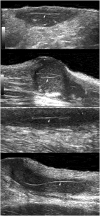Ultrasound and Infrared-Based Imaging Modalities for Diagnosis and Management of Cutaneous Diseases
- PMID: 29922650
- PMCID: PMC5996893
- DOI: 10.3389/fmed.2018.00115
Ultrasound and Infrared-Based Imaging Modalities for Diagnosis and Management of Cutaneous Diseases
Abstract
Non-invasive bedside imaging tools are becoming more prevalent for assessing cutaneous lesions. Ultrasound used at specific frequencies allows us to assess margins of lesions to minimize the extent of the biopsy that is performed and improve cosmetic outcomes. Vascularity, seen on Doppler ultrasound and contrast-enhanced ultrasound, and stiffness, assessed on tissue elastography, can help differentiate between benign and malignant lesions for clinicians to be more judicious in deciding whether to biopsy. Moreover, research has shown the efficacy in using ultrasound in monitoring flares of hidradenitis suppurativa, a disease affecting apocrine gland-rich areas of the body, for which the current gold standard involves examining and scoring inflammatory lesions with the naked eye. Infrared-based modalities have also been on the uptrend to aid in clinical decision-making regarding suspiciousness of lesions. Reflectance confocal microscopy has lateral resolution that is comparable to histopathology and it has been shown to be an appropriate adjunctive tool to dermoscopy, specifically when evaluating melanomas. Optical coherence tomography has utility in determining lesion thickness because of its depth penetration, and spectrophotometric intracutaneous analysis is becoming more popular as a tool that can be used by general practitioners to know when to refer to dermatology regarding worrisome pigmented lesions. Strides have been made to incorporate electrical impedance spectroscopy alongside dermoscopy in decision-making regarding excision, although the evidence for its use in the clincial setting remains inconclusive. This paper reviews the efficacy and drawbacks of these techniques in the field of dermatology and suggests future directions.
Keywords: dermatology; electrical impedance spectroscopy; hidradenitis suppurativa; non-invasive imaging; optical coherence tomography; reflectance confocal microscopy; spectrophotometric intracutaneous analysis; ultrasound.
Figures






Similar articles
-
Role of In Vivo Reflectance Confocal Microscopy in the Analysis of Melanocytic Lesions.Acta Dermatovenerol Croat. 2018 Apr;26(1):64-67. Acta Dermatovenerol Croat. 2018. PMID: 29782304 Review.
-
Optical coherence tomography in dermatology.G Ital Dermatol Venereol. 2015 Oct;150(5):603-15. Epub 2015 Jul 1. G Ital Dermatol Venereol. 2015. PMID: 26129683 Review.
-
Non-invasive tools for the diagnosis of cutaneous melanoma.Skin Res Technol. 2017 Aug;23(3):261-271. doi: 10.1111/srt.12350. Epub 2016 Nov 22. Skin Res Technol. 2017. PMID: 27878858 Review.
-
Differentiation Between Benign and Malignant Pigmented Skin Tumours Using Bedside Diagnostic Imaging Technologies: A Pilot Study.Acta Derm Venereol. 2022 Jan 26;102:adv00634. doi: 10.2340/actadv.v101.571. Acta Derm Venereol. 2022. PMID: 34806755 Free PMC article.
-
Current uses of diagnostic high-frequency US in dermatology.Eur J Radiol. 1998 May;27 Suppl 2:S215-23. doi: 10.1016/s0720-048x(98)00065-5. Eur J Radiol. 1998. PMID: 9652525
Cited by
-
Non-contrast-enhanced 3-Tesla Magnetic Resonance Imaging Using Surface-coil and Sonography for Assessment of Hidradenitis Suppurativa Lesions.Acta Derm Venereol. 2020 Nov 12;100(18):adv00317. doi: 10.2340/00015555-3639. Acta Derm Venereol. 2020. PMID: 32945342 Free PMC article. Review.
-
Utility of a gel stand-off pad in the detection of Doppler signal on focal nodular lesions of the skin.J Ultrasound. 2020 Mar;23(1):45-53. doi: 10.1007/s40477-019-00376-3. Epub 2019 Mar 29. J Ultrasound. 2020. PMID: 30927249 Free PMC article.
-
1.7-Micron Optical Coherence Tomography Angiography for Characterization of Skin Lesions-A Feasibility Study.IEEE Trans Med Imaging. 2021 Sep;40(9):2507-2512. doi: 10.1109/TMI.2021.3081066. Epub 2021 Aug 31. IEEE Trans Med Imaging. 2021. PMID: 33999817 Free PMC article.
-
A Scoping Review of Non-invasive Imaging Modalities in Dermatological Disease: Potential Novel Biomarkers in Hidradenitis Suppurativa.Front Med (Lausanne). 2019 Nov 6;6:253. doi: 10.3389/fmed.2019.00253. eCollection 2019. Front Med (Lausanne). 2019. PMID: 31781567 Free PMC article.
-
The Role of FDG-PET in the Evaluation of Hidradenitis Suppurativa: A Systematic Review.J Clin Med. 2023 Aug 24;12(17):5491. doi: 10.3390/jcm12175491. J Clin Med. 2023. PMID: 37685556 Free PMC article. Review.
References
-
- Tehrani H, Walls J, Price G, Cotton S, Sassoon EM, Hall PN. A prospective comparison of spectrophotometric intracutaneous analysis to clinical judgement in the diagnosis of nonmelanoma skin cancer. Ann Plast Surg (2007) 58:209–11.10.1097/01.sap.0000235476.10517.bb - DOI - PubMed
-
- MoleMate™SIMSYS™. About SIMSYS-MoleMate™. SIASscopy™: All Things MedX. (2017). Available from: http://www.medxhealth.com/Our-Products/SIAscopytrade;/overview.aspx (Accessed: December 9, 2017).
Publication types
LinkOut - more resources
Full Text Sources
Other Literature Sources

